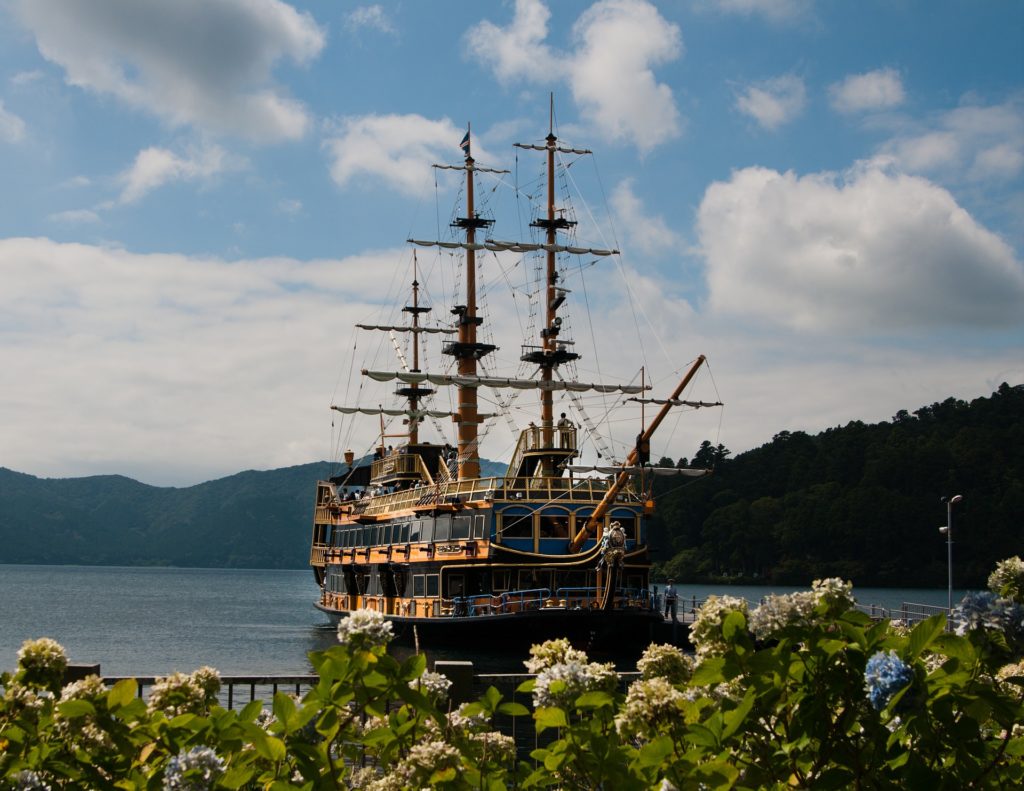Home to some of Japan’s most beautiful natural attractions, Hakone is a town in the Fuji-Hakone-Izu National Park, situated less than two hours by train or bus from Tokyo. It offers a wide selection of relaxing natural hot springs, various educational and informative museums, and fantastic views of the majestic Mount Fuji.
How To Get There
Hakone is accessible via trains or buses.
To get there from Tokyo, you can travel on the Odakyu Railway Line from Shinjuku Station to Hakone-Yumoto Station. The one-way trip takes approximately an hour and a half. Alternatively, you can take a Shinkansen, a JR local train, or a JR rapid train from Tokyo to Odawara Station, and transfer to non-JR lines or buses to reach the Hakone area.
If you prefer to travel by bus, there are Odakyu Hakone Highway buses that depart from Shinjuku Station and stop at different points in the Hakone area. Fares, timetables, and other information are found on Odakyu Hakone Highway Bus’ official website.
To access Hakone from Kyoto or Osaka, take a Shinkansen ride to Mishima Station, Atami Station, or Odawara Station, and then transfer to a Hakone area bus.
Top Attractions
Hot Springs
Hakone has some of the best hot springs Japan has to offer. Its natural hot spring waters are top notch, and have been proven to give a relaxing and therapeutic effect.
In Hakone, there are numerous ryokan that offer hot spring baths and overnight accommodations that usually include traditional meals served for breakfast or dinner. Moreover, It has several outdoor and indoor, public and private bath houses that welcome daytime visitors who just want a quick dip.
If you need help looking for a ryokan or a hot spring bath house in Hakone, check out the listings on online booking sites, such as Japanese Guest Houses and Japanican.
Hakone Ropeway
The Hakone Ropeway provides an opportunity to get stunning views of Owakudani Valley and its sulfuric hot springs from above. It extends from Sounzan and Owakudani, and takes approximately 30 minutes to traverse, aboard a gondola.
Visit Hakone Ropeway’s official website for information on fares, timetables, and more.
Owakudani
Owakudani is an active volcanic zone, found around the crater of Mount Hakone. Even though the volcano’s last eruption was about 3,000 years ago, the area remains abundant in sulfur gases, and offers very hot rivers and springs where visitors can cook eggs.
One very popular activity to do in Owakudani is purchasing eggs there, and cooking them in the volcano’s natural boiling hot waters that later turn the egg shells to black due to sulfur. These cooked, blackened eggs are believed to be able to extend one’s life by as many as seven years.
Lake Ashinoko

Mount Hakone’s eruption 3,000 years ago created Lake Ashinoko, a scenic lake with excellent views of Mount Fuji.
To best explore the lake, join a sightseeing boat cruise via the Hakone Sightseeing Boats and Izuhakone Sightseeing Boats companies. The boats travel from the lake’s northern end to its southern end (or vice versa) and take approximately half an hour.
Hakone Open Air Museum
The Hakone Open Air Museum offers a unique museum experience, as its exhibits are displayed out in the open, with incredible views of the mountains and nature all around. It features art pieces made by a variety of local and international artists, including the works of renowned Spanish painter and sculptor Pablo Picasso, which can all be viewed at the Picasso Exhibition Hall. It also has various other special spaces and sections that not only cater to adults but to children as well.
To find out when the best time to visit the museum is, what the ticket prices are, what the current exhibitions are, and how to get to the museum, visit Hakone Open Air Museum’s official website.
Hakone Tozan Railway
For train enthusiasts visiting Hakone, it is a must to ride the Hakone Tozan Railway. Recognized as the oldest mountain railway in Japan, it follows a route that goes into the dense forests of the national park, passing through several tunnels, and going over bridges with amazing views of the valley.
In the summer, the ride lets you enjoy the beautiful hydrangea growing along the tracks, and, at night, these flowers are illuminated, making them look more spectacular.
Fares, timetables, and other information are available on Hakone Tozan Railway’s official website.
Hakone Shrine
Found at the foot of Mount Hakone, on the shores of Lake Ashi, Hakone Shrine is an 8th century Japanese Shinto shrine that offers scenic views of the lake, forests, and mountains. It is made up of three large torii gates, with one of them standing right in the lake waters. It has a pleasant hiking trail that is adorned by lanterns in the middle of the woods, and leads to the shrine’s main building.
(A Hakone Shrine torii gate – Source: https://unsplash.com/photos/SBK40fdKbAg)
Hakone Checkpoint
Back in the Edo Period, Hakone served as an integral traffic checkpoint along the Tokaido highway between Tokyo and Kyoto. Today, this site is a historic attraction, with cedar trees lining the passage of the reconstructed building. Its immediate vicinity includes a couple of museums, a lookout tower, and a preserved stone pavement walking trail.
Hours of operation and other information can be found on Hakone Checkpoint’s official website.
Getting Around
Hakone is served by an extensive network of public transportation composed of sightseeing boats, trains, ropeways, and buses, so getting from one attraction to another should not be difficult.
And, for convenience and to save money, you may want to look into buying a Hakone Free Pass.
The Hakone Free Pass comes in two types: the 2-day pass, which costs 5,140 yen (if purchased at Shinjuku Station) or 4,000 yen (if purchased at Odawara Station and within the Hakone area); and the 3-day pass, which costs 5,640 yen (if purchased at Shinjuku Station) or 4,500 yen (if purchased at Odawara Station and within the Hakone area). It is valid on all buses, trains, ropeways, and boats in the free area.
More information on Hakone Free Pass is available on Odakyu’s Hakone Free Pass page.
Weather
From June to October, Hakone experiences a lot of rain. Its hottest month is August, when daily temperatures hover in the low 20s Celsius. In the spring and autumn seasons, temperatures fall between 5 and 10 degrees Celsius, and in winter, the days are generally dry but really cold, with temperatures often dipping below 0.
